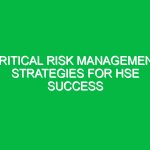Introduction
In the complex world of Health, Safety, and Environment (HSE) management, risk control in risk management stands as a pivotal concept aimed at ensuring the Safety and well-being of individuals and the environment. This term refers to the systematic approaches and measures taken to identify, assess, and mitigate risks that can lead to accidents, injuries, or environmental damage. Effective risk control is not merely a regulatory obligation; it is a fundamental aspect of fostering a culture of Safety that Benefits organizations, employees, and the communities they serve.
Imagine a manufacturing facility where machinery operates at full capacity. Without appropriate risk Control Measures, the potential for accidents increases dramatically. Implementing risk management strategies not only protects workers but also enhances productivity by creating a safer work environment. This article delves into the critical aspects of risk control in risk management within the HSE context, exploring methodologies, regulations, and real-world applications that can lead to safety success.
Understanding Risk Control in Risk Management
Risk control in risk management encompasses a range of practices designed to reduce or eliminate Hazards that could lead to adverse outcomes. It involves a continuous cycle of risk assessment, mitigation strategies, and monitoring. The primary goal is not just compliance with Regulations but the creation of a proactive safety culture that anticipates and addresses potential issues before they escalate.
Key Components of Risk Control
To effectively implement risk control within HSE management, organizations should focus on several key components:
- Risk Identification: The first step involves recognizing potential Hazards in the workplace. This can include everything from chemical spills to ergonomic issues.
- Risk Assessment: Once hazards are identified, the next step is to evaluate the risks associated with them. This involves determining the likelihood of occurrence and the potential severity of the consequences.
- Risk Mitigation: After assessing risks, organizations must develop strategies to minimize or eliminate them. This could involve engineering controls, administrative changes, or the use of Personal Protective Equipment (PPE).
- Monitoring and Review: Risk control is an ongoing process. Regular monitoring of Safety Measures and review of incidents helps organizations adapt and improve their risk management strategies over time.
Benefits of Effective Risk Control
Implementing robust risk Control Measures within HSE management yields numerous benefits:
- Enhanced Safety: The most immediate benefit is the protection of employees and the environment. A well-structured risk control program leads to fewer accidents and injuries.
- Regulatory Compliance: Effective risk management helps organizations adhere to industry Standards and legal requirements, reducing the risk of fines and legal action.
- Improved Reputation: Organizations known for prioritizing safety often enjoy a positive reputation, attracting talent and customers alike.
- Cost Savings: By preventing accidents and incidents, organizations can save significant amounts on insurance premiums, legal fees, and lost productivity.
Best Practices for Risk Control
To maximize the effectiveness of risk control in risk management, organizations should adopt the following Best Practices:
- Engagement and Training: Empower employees through training programs that educate them about risks and safety protocols. Engaged employees are more likely to adhere to Safety Measures.
- Clear Communication: Establish open lines of communication regarding safety concerns. Employees should feel comfortable reporting hazards without fear of retribution.
- Regular Audits: Conduct periodic audits of safety practices and risk control measures. This helps identify areas for improvement and ensures compliance with established protocols.
- Use of Technology: Leverage technology such as safety management software and data analytics to streamline risk assessment and control processes.
Identifying Hazards and Risks
Effective risk control starts with a thorough understanding of potential hazards. These can be categorized into several types:
- Physical Hazards: Include machinery, slips, trips, and falls. For example, a construction site poses significant physical hazards due to heavy equipment and uneven surfaces.
- Chemical Hazards: Involve exposure to harmful substances. A chemical manufacturing plant must implement stringent controls to handle Toxic Materials safely.
- Biological Hazards: Arise from exposure to harmful microorganisms. Healthcare facilities must have protocols in place to manage exposure risks.
- Ergonomic Hazards: Result from awkward work positions or repetitive motions. Offices should assess workstation setups to prevent musculoskeletal disorders.
Real-Life Example: A Manufacturing Case Study
Consider the case of a large manufacturing company that faced frequent injuries related to machine Operation. After conducting a comprehensive risk assessment, the company identified that many incidents were due to inadequate training and improper use of machinery.
In response, the organization revamped its training program, introducing hands-on workshops and safety simulations. They also implemented regular safety audits and feedback sessions, fostering a culture of open communication. Over the next year, the company saw a dramatic reduction in accidents—by nearly 40%—demonstrating the effectiveness of risk control in risk management.
Regulations and Standards
Understanding the legal landscape surrounding risk control is crucial for organizations. Various regulations and standards govern HSE management, including:
- Occupational Safety and Health Administration (OSHA): In the United States, osha sets and enforces standards to ensure safe working conditions. Compliance with OSHA regulations is essential for risk control.
- ISO 45001: This international standard provides a framework for Occupational Health and safety management systems, emphasizing risk control and continuous improvement.
- Environmental Protection Agency (EPA): Regulations from the EPA focus on environmental protection, requiring organizations to manage risks associated with hazardous materials and waste.
Impact of Regulations on Risk Control
Adhering to these regulations not only ensures compliance but significantly enhances risk control efforts. For instance, OSHA requires employers to conduct regular safety training and risk assessments, directly influencing how organizations implement and maintain risk control measures. Failure to comply can lead to severe penalties, but more importantly, it can compromise employee safety and organizational integrity.
Conclusion
Unlocking effective risk control in risk management is not just a best practice; it is essential for ensuring safety and Sustainability in the HSE domain. By understanding the key components of risk control, embracing Best Practices, and adhering to regulations, organizations can foster a culture of safety that protects employees, enhances productivity, and contributes to environmental stewardship.
As industries continue to evolve, so too must our approaches to risk management. By prioritizing risk control, organizations can navigate the complexities of modern HSE challenges while achieving safety success. It’s not merely about compliance; it’s about creating a safer world for everyone. Organizations must take action today to implement these strategies, ensuring a healthier, safer tomorrow for their employees and the environment.


